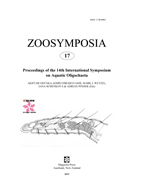Abstract
In the 1960s it became fairly well-known that biological indices through their supposedly integrative power could be more robust measures of the water quality than separate chemical data. Oligochaetes and chironomid larvae in the bottom fauna hereby played an important role. Precision, however, increased dramatically if the relationship between oligochaetes and the so-called morpho-edaphic index, i.e. the average total phosphorus content in µg/l divided by the mean depth (in meters) of the lake (Ryder et al., 1974), was used in stead (Milbrink, 1978). The percentage composition and total abundance of oligochaetes in a number of lakes or selected basins of large lakes in southern Sweden and Norway were thus tested against this index in the 1970s. In logarithmic scales these relationships turned out to be more or less linear. The immediate conclusions were then that this method of classifying lakes could be of considerable scientific as well as practical value. Today we know a lot more about the ecological preferences of oligochaete species and characteristic species associations. The oligochaete fauna of the large lakes of southern Sweden, Mälaren, Vättern, Vänern and Hjälmaren, have been studied in detail over many years—over 100 years in the first three of these lakes and in the last lake for over 50-years. Effects of generally applied advanced sewage treatment in Sweden since the late 1960s are easily recognizable in the material. We have a situation of oligotrophication. With our new knowledge it comes natural today to study changes in species composition after trophic change and to investigate if the above close relationships in abundance are still largely linear.
References
Brinkhurst, R.O. (1966) The Tubificidae (Oligochaeta) of polluted water. Verhandlungen des Internationalen Verein Limnologie, 16, 854–859.
Lang, C. (1984) Eutrophication of Lakes Leman and Neuchatel (Switzerland) indicated by oligotrophic communities. Hydrobiologia, 115 (1), 131–138.
Lang, C. & Reymond, O. (1996) Reversal of eutrophication in four Swiss lakes: evidence from oligochaete communities. Hydrobiolgia, 334 (1–3), 157–161.
Liebmann, H. (1962) Handbuch der Frischwasser- und Abwasserbiologie. Band I.R. Oldenbourg, München, 588 pp.
Milbrink, G. (1978) Indicator communities of oligochaetes in Scandinavian lakes. Verhandlungen der Internationale Vereinigung der Limnologie, 20, 2406–2411.
Milbrink, G. (1980) Oligochaete communities in pollution biology. The European situation with special reference to lakes in Scandinavia. In: Brinkhurst, R.O. & Cook, D.G. (Eds.), Aquatic Oligochaete Biology. Plenum Press, pp. 433–455.
Milbrink, G. (1983) Characteristic diformities in tubificid oligochaetes inhabiting polluted bays of Lake Vänern, Southern Sweden. Hydrobiologia, 106, 169–184.
Milbrink, G. (1999) Distribution and dispersal capacity of the Ponto-Caspian tubificid oligochaete Potamothrix heuscheri (Bretscher, 1900) in Scandinavia. Hydrobiologia, 406, 133–142.
Ryder, R.A., Kerr, S.R., Loftus, K.H. & Regier, H.A. (1974) The morphoedaphic index, a fish yield estimator review and evaluation. Journal of the Fisheries Research Board of Canada, 31 (5), 663–688.
Zelinka, M. & Marvan, P. (1961) Zur Präzisierung der biologischen klassifikation der reinheit fliessender Gewässer. Archiev für Hydrobiologie, 57, 1–20.

